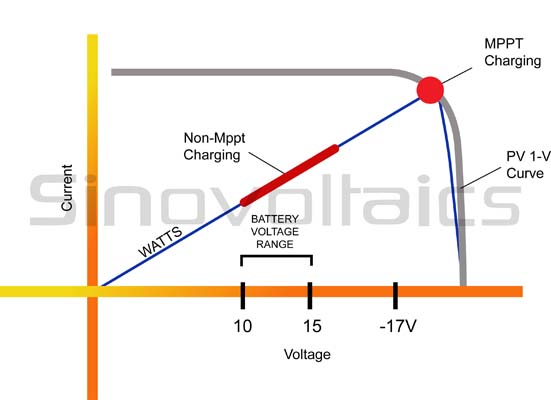MPPT Charge Controllers: what is MPPT and its advantages
MPPT Charge Controllers or Maximum Power Point Tracking Charge Controllers are a type of charge controllers that track the power for the maximum power point.
What is an MPPT Charge Controller?
The MPPT charge controller ensures that the loads receive maximum current to be used (by quickly charging the battery). Maximum power point could be understood as an ideal voltage at which the maximum power is delivered to the loads, with minimum losses. This is also commonly referred to as peak power voltage.
What is the maximum power point (MPP)?
The maximum power point (MPP) describes the point on a current voltage (I-V) curve at which the solar PV device generates the largest output i.e. where the product of current intensity (I) and voltage (V) is maximum. The MPP may change due to external factors such as temperature, light conditions and workmanship of the device. In order to ensure maximum power output (Pmax) of a solar PV device in view of these external factors, maximum power output trackers (MPPT) may be operated to regulate the resistance of the device.
How do MPPT charge controllers work?
Anyone familiar with the charging and discharging characteristics of the battery is familiar to the fact that the voltage of the battery varies with its charge content. As current flows from a high potential to low potential, the steeper the gradient or voltage difference, the greater is the flow of current. This potential gradient could be made steeper by two ways:
- By increasing the output voltage of the Solar Panel
- By decreasing the voltage of the battery (discharging the battery)
[caption id="attachment_4817" align="aligncenter" width="551"] MPPT Charge Controller - Maximum Power Point[/caption]
MPPT Charge Controller - Maximum Power Point[/caption]
Using increased panel voltage to deliver maximum power
Now batteries could only be charged if the output voltage of the solar panel is greater than that of the batteries, to facilitate a flow of current from the panel to the battery. The output voltage of the panel depends on different factors, including the weather (irradiance). On a sunny day the output voltage may be higher than the rated output voltage, while during a cloudy day the output voltage is probably less. Normal controllers do not have the capacity to utilize this higher output voltage to deliver more power. However MPPT charge controllers have the ability to adjust the voltage in order to get a boost of current during times of peak demand. MPPT delivers higher than rated charge to the battery as they can adjust the voltage to current ratio.
Using battery voltage for delivering maximum power
Current and Voltage are inversely proportional to each other. With other words, if the current increases, the voltage drops and vice versa. By lowering the current by introducing some resistance in the path of the current, the MPPT charge controller can boost up the voltage. This voltage to current ratio adjustment is called Maximum power point tracking. MPPT typically increases the current to the battery by approximately 25% to 30%. Important to keep in mind is that a 80% discharged battery will charge faster than a 50% discharged battery. The reason for this is that when the battery starts to discharge, its voltage also reduces. The larger the gap between the solar panel output voltage and the battery voltage, the more current will flow into the battery, and the faster the battery will be charged.
Combined techniques for optimum battery charging
MPPT charge controllers use both principles mentioned above to deliver the maximum amount of power. This type of solar charge controllers come pre-programmed with adjustable set-points which can be edited and adjusted according to your needs. If you need to choose between a standard and a MPPT charge controller, usually paying a bit more for a proper MPPT controller is the way to go.
Let’s Talk About Your System
Want to ensure you’re using the right MPPT controller for your panel array, voltage conditions and battery-load configuration? Reach out to our team — we’ll walk you through how to size and configure MPPT controllers, optimise the system for performance and longevity, and match components based on your real-world conditions. [Talk with us today →]

Jon Stivers
on 25 Jan 2023Steve
on 26 Feb 2023Darrell
on 18 Apr 2022ADR
on 03 Jan 2022akinmade temitope
on 24 Mar 2017Danladi A. Birdling
on 20 Aug 2018Jayanta bhuyan
on 13 Jul 2018Bob B
on 08 Mar 2019Azli
on 28 Jun 2019Njuba
on 18 Dec 2019